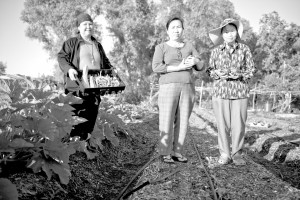Open spaces in New Orleans East are used to raise food, flowers
23rd October 2017 · 0 Comments
By Susan Buchanan
Contributing Writer
In New Orleans East, home to more open land than the rest of the city, farmers produce vegetables, herbs, tofu and flowers, using as few chemicals as possible. The city’s restaurants, outdoor markets and grocery stores are regular customers. The East has withstood post-Katrina recommendations that it revert to wetlands.
Village de L’Est Green Growers Initiative, or VEGGI Farmers Cooperative for short, was formed after BP’s oil spill in 2010 left Vietnamese-American shrimpers without work. A much larger farm, planned by the development arm of the community’s Mary Queen of Vietnam Church after Katrina, fell through. VEGGI is a smaller project of MQVN Community Develop-ment Corporation, but its growers control the farm, Khai Nguyen, a program officer at MQVN CDC and VEGGI said last week.
The larger project crumbled because the U.S. Army Corps of Engineers viewed the 28 acres that would have been used as jurisdictional wetlands, Nguyen said. The area was protected by the Corps from development unless the CDC could purchase mitigation credits to replace the land being farmed. The CDC couldn’t find money for the credits, which were based on acreage prices and expensive. It abandoned the project.
Today over 5,000 Vietnamese-Americans live in New Orleans East, where refugee families settled after they left their war-torn homeland in the 1970s. “The BP spill left our shrimpers, fishermen, shrimp peelers, oyster shuckers and restaurant workers and owners out of work for a year or more,” Nguyen said. Fishing areas in the Gulf of Mexico were closed. The incomes of 30 percent of the area’s Vietnamese community took a direct hit, and many more of its members suffered indirectly.
“Before and after Katrina, families here have grown vegetables in their yards for themselves and for selling, bartering or sharing,” Nguyen said. “Produce is left on the steps of my mother’s house every week,” he said. The community’s dependence on the land and Gulf waters made Katrina and the BP spill especially devastating. At the time of the 2010 spill, only a few grocery stores had reopened in the East in the nearly five years since Katrina.
When the idea of a farm co-op was floated in 2010, enterprising, but out-of-work shrimpers were skeptical of doing anything jointly. Their families had fled communism in Vietnam 40 years earlier. But VEGGI was structured so that growers could keep most of their earnings. “What a farmer earns goes back to the farmer,” Nguyen said.
In 2011, VEGGI began tilling one acre on a three-acre site near MQVN. “I wouldn’t call the area wetlands,” Nguyen said. “When I first looked at it, the site was a pretty solid, overgrown lot.” The co-op leases the land from a community member for a small, below-market rent. A grant from nonprofit Oxfam America and assistance from foundations, Delgado Community College and the city’s Job 1 workforce program helped VEGGI launch. In late 2011, twelve community members were trained to build and use greenhouses and aquaponics technology on their properties.
Plants grown by VEGGI are on raised beds in gardening soil, purchased from Wood Materials, a supplier in Harahan, Nguyen said. Raised planter boxes are allowed for food crops under the city’s Comprehensive Zoning Ordinance. VEGGI’s farmers have seeds, and they also buy from Johnny Seeds, based in Maine. “Everything we use is as natural possible,” Nguyen said. “Some farmers use pesticides, but they make sure they’re organic. The water we use is from the city, not the pond on the site.” Though the water’s treated and not entirely natural, it is clean.
Members pay the co-op, which keeps a running ledger, a 25-percent fee on the sale of their products. “The fee covers delivery expenses, fuel, shared tools and equipment,” Nguyen said. VEGGI files taxes as a nonprofit. Pooled sales and marketing give its growers access to customers all over New Orleans. VEGGI’s members report earnings on their own tax returns.
“Right now we have six members, so we’re still pretty small,” Nguyen said. VEGGI’s growers have four greenhouses and three aquaponics systems. “Our farmers learn from others, but they’re all skilled,” he said. “Their skills, along with their commitment and passion, make them successful. We have volunteer days, but growers mostly take care of these plots themselves.”
Since VEGGI’s founding , the community’s shrimpers and fishermen have returned to the water. “But others have taken their place as farmers,” Nguyen said. “Members are earning $20,000 to $25,000 a year. That’s supplemental income for some of them. One lady who makes tofu earns $50,000 a year.” While it’s preferable to buy locally, the soybeans VEGGI uses come from a Nebraska supplier under an arrangement dating back several years, he said.
In addition to raised beds, VEGGI uses aquaponics to grow vegetables. Water from fish tanks, enriched with nitrates, flows through troughs that have plants placed on floating foam rafts. The roots soak up the nitrate-enriched water. Then the water is circulated back into the fish tanks. Plants grow faster using this method than they do in soils, and taste and quality don’t suffer, according to VEGGI.
VEGGI sells to over thirty New Orleans restaurants and grocery stores and to the Crescent City Farmers Market and other outdoor marts. “Many of the local chefs know us and support us,” Nguyen said. Restaurant customers include Carmo, Satsuma, 1,000 Figs, Dante’s Kitchen, Brigtsen’s, MoPho, Maypop and Boucherie.
The Vietnamese community is religious, and its close-knit ways support group endeavors, Nguyen said. MQVN CDC was established in the East in 2006 by leaders of the MQVN Church to help residents rebuild from Katrina. After Katrina destroyed the area’s gardens, Tulane University, the University of Montana and others worked with the CDC to reestablish them.
Until recently, Megan Webbeking ran NOLA Tilth on a site of less than an acre next to VEGGI. She grew flowers and a few vegetables, and did most of the gardening herself with the help of volunteers—who took produce home. “We were going to make it half vegetables, but we kept it mostly flowers,” she said last week. “People really enjoyed working together in the sun and in the beauty of the flowers.” Her day starts early, and to be closer to her Bywater home, she has moved operations to the St. Claude Flower Farm on France Street. The New Orleans Flower Collective has taken over her old space in New Orleans East and is farming there this fall.
“Our flowers haven’t been sprayed with harsh chemicals or pesticides,” Webbeking said. “Who wants to put anything covered in chemicals on their table?” She said practices using compost, cover cropping and mulching, rather than fertilizers, help a community’s soils.
Flower farmers here and nationally were calling it quits for awhile. “Twenty years ago, Louisiana had more flower growers, but the industry began to die out because of federal policies supporting growers elsewhere, especially in Colombia,” Webbeking said. “Trade policies made it cheaper to buy flowers from other countries.” Sustainable flower farming is making a comeback now, however. “People want to buy chemical-free products and support the local economy,” she said.
For VEGGI, St. Claude Flower Farm and the New Orleans Flower Collective, growing weather—mainly too little or too much rain—is always a concern.
“And like most nonprofits, a big challenge for us is raising money for projects,” Nguyen said. VEGGI hopes to build a commercial kitchen soon. In addition to vegetables and herbs, the co-op is known for its flavored tofu—chili lemongrass and mushroom vermicelli. Customers buy weekly boxes of salad fixings, herbs and other products on VEGGI’s website. Flowers can be purchased through the gardens’ on-line sites.
This article originally published in the October 23, 2017 print edition of The Louisiana Weekly newspaper.




